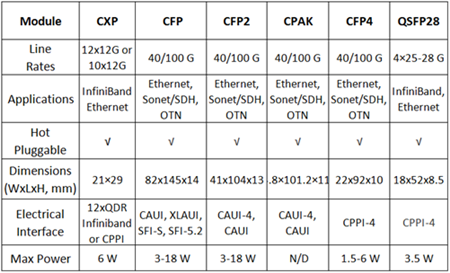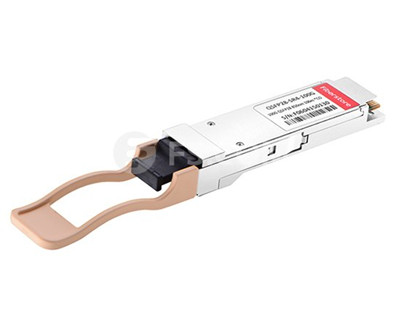2015 witnessed the prosperity of the telecom market. Many research company predicts that the market of 2016 for telecommunication field will continue to thrive. With such a bright future, fiber optics market attracts a wide attention and many vendors want a piece of the pie. At present, 40G is ubiquitous in the data center and 100G is accelerating. As for the optical transceiver, it has been developed in the past decades to adapt to the high-speed requirement from 1G to 40G even to 100G. Believe it or not, 100G is coming. So, what can we do to make us well-prepared for the upcoming 100G era? How about the 100G optical transceivers?
100G Optical Transceiver Modules
There are many form factors of 100G transceivers including CXP, CFP, CFP2, CPAK, CFP4 and QSFP28. Among them, QSFP28 and CFP optical transceiver are the most commonly used 100G transceivers. The following figure shows a comparison between 100G transceivers.

CFP Transceiver—CFP transceiver was designed after SFP transceiver interface, but it supports much larger internet speed, which is realized by using 10×10Gbit/s in each direction. The c stands for the Latin letter C meaning the number 100 (centum). The 100G optical interconnects typically means 100GBASE-SR10 in 100 meter MMF, 100GBASE-LR10 and 100GBASE-LR4 in 10km SMF reach, and 100GBASE-ER10 and 100GBASE-ER4 in 40km SMF reach respectively. CFP transceiver is currently defined two next-generation 100G form factors — CFP2 and CFP4. Compared to the existing CFP, CFP2 and CFP4 will be respectively double and quadruple front panel port density.
CFP vs. CXP—As noted before, CFP use the 10-lane CAUI-10 electrical interface. While CXP modules use the CAUI-10 electrical interface, which is a multi-source agreement to produce a common form-factor for the transmission of high-speed digital signals. CXP optical transceiver is hot pluggable, and supports data rates of 40 Gbps. The CFP transceiver, as detailed in the MSA, supports both single-mode and multimode fiber and a variety of data rates, protocols, and link lengths, including all the physical media-dependent (PMD) interfaces, which is targeted at the clustering and high-speed computing markets.
QSFP28 Transceiver—The QSFP28 transceiver and interconnect cable is a high-density, high-speed product solution designed for applications in the telecommunications, data center and networking markets. The interconnect offers four channels of high-speed differential signals with data rates ranging from 25 Gbps up to potentially 40 Gbps, and will meet 100 Gbps Ethernet (4x25 Gbps) and 100 Gbps 4X InfiniBand Enhanced Data Rate (EDR) requirements. In addition, the surge of QSFP28 shipments will be one of the factors to change the market from 40G to 100G, according to IHS. QSFP28 is fast becoming the universal data center form factor. Furthermore, the prospects of 100G DAC (Direct Attach Cable) and 100G WDM transceiver also show good momentum. QSFP28 transceiver is typically available in two standard—100GBASE-SR4 and 100GBASE-LR4. QSFP28-100G-SR4 operates at multimode fiber for a distance of 100 m. 100GBASE-LR4 QSFP28 can support a much longer distance of 10 km. The following image shows a 100GBASE-SR4 QSFP28 transceiver module.

The 100G transceiver modules will be applied in two major areas—telecom (includes LTE and FTTx) and data center. Data center may be the main battle for 100G optics because data center transceivers account for 65% of the overall 10G/40G/100G optical transceiver market. In 2016, the global data center construction market will keep growing which means that the 100G optics application will be more wider. Geographically, North America, Europe and Asia-Pacific (mainly China) are the main market for 100G transceiver with their increasing demand for deployment of 100G equipment.
Conclusion
No one can predict whether 100G will be popular or not, only time will do. Just make your self well prepared for the rainy day. As 100G technology becomes mature and relevant optical devices are more affordable, it is a wise decision for you to upgrade to 100G. Fiberstore is committed to provide the first-class services and high-quality products to customers. For 100G optics, they introduced the 100GBASE-LR4 CFP2 and CFP4 modules as well as the 100GBASE-SR4 and 100GBASE-LR4 QSFP28 modules. With serious cost control, the prices of all 100G optics are much more affordable than the similar products on the market.
Well, that’s a good way to put it, nice insights, works great in clientele explanation and information resource option.
回复删除Cat6 Cabling Services